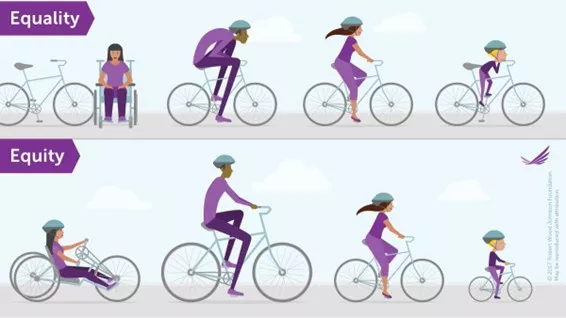
International Women's Day... Making life at work more equitable
9 March 2023
This year, International Women's Day is teaching us to 'Embrace Equity'. What is equity? Why does it matter? How do we embed equity into our workplaces? Read on to discover how to create more opportunities for your people to thrive.
Wednesday 8th March was International Women’s Day, and this year the message is about Embracing Equity.
The concept of equity is often confused with equality, and whilst you can’t achieve equity without equality, they are different.
Equality Vs. Equity
This image, created by Robert Wood Johnson Foundation, clearly illustrates the difference between equality and equity.

Equality
The image shows that the concept of equality means that everyone is treated the same.
Consider that every person in the image has been given the same bike and told to ride it. This appears to be fair and equal on paper because everyone has been given the same bike. However, only one person has been given the right bike for their personal needs, meaning their chance of success is better than the rest.
Equity
With the equity example, everyone has been given the same brief – ride the bike – but each person’s specific needs have been considered, and they’ve been given the right ‘tool’ to help them achieve the goal.
This is equity summed up: taking the concept of equality but considering individual circumstances. It creates an environment that embodies fair treatment, access, and opportunity by eliminating the barriers that may hinder success.
Women in leadership
In the UK, 40% of UK FTSE 100 board positions are now held by women, the second largest figure internationally. Ten years ago, this figure was at 12.5%.
That said, there are still significant barriers for women in the workplace, even those in leadership positions.
According to a 2022 report by McKinsey, women leaders are twice as likely as men leaders to be mistaken for someone more junior. The same report also found that women leaders are more likely to support employee wellbeing and diversity, equity, and inclusion. However, many women report that these beneficial actions aren't acknowledged during performance reviews.
Achieving equity
Equity is more than a gender matter. However, since it’s the theme of International Women's Day, we’re focusing on the gender divide in the workplace.
Leadership
As part of our IWD initiatives here at Pluxee UK, we welcomed Jude Jennison, founder of Leaders By Nature, to talk our employees through her OPUS methodology - the 12 ‘hidden dynamics’ of leadership - and how to use it to embed equity into your organisation.
There was a strong focus on judgment, assumptions, and the impact of non-verbal communication. From a managerial and leadership perspective, Jude explained the importance of awareness and understanding the different needs and ways individual members of your team may work. Jude paid particular attention to the fact that leaders must take extra care to look out for the people in their teams who may not speak up, as their needs are less likely to be met.
Family life
An organisation striving for equality would argue that it’s fair for men and women to have the same support when returning to work after parental leave.
Whilst this ticks the box for equality, it’s not an equitable approach.
Using a heterosexual relationship as an example. Unless parental leave is due to adoption or surrogacy, the situation is different for the man and the woman. Whilst having a baby is a significant life event for men and women alike, men don’t undergo the same physical experience as women, and their return-to-work support needs will be significantly different.
To achieve equity, each employee must have a bespoke plan created.
Equity in employee benefits
One approach to employee benefits is to offer the same benefits to all. Whilst this looks fair and equal, it’s not an equitable approach.
For example, let's say you offer all employees private medical insurance (PMI) and childcare vouchers. Whilst it’s an equal approach because it’s accessible to all and incorporates physical and financial wellbeing benefits, it’s not equitable.
Childcare vouchers may be utilised and appreciated by working parents, but what of the employees who do not have children?
What financial wellbeing benefit is being made available to them?
Likewise, as we found in our blog – How to Boost the Uptake of Your Employee Benefits Offering – employees in the 25 to 34 age range are less likely to be interested in PMI than their older colleagues. That’s not to say that physical wellbeing isn’t of interest to them because research suggests that they’re more likely to have a gym membership. As such, a corporate gym membership is a more appropriate physical wellbeing benefit for that group.
There’s no one-fits-all solution when it comes to employee benefits.
Whilst it may seem equal to offer the same benefits (or bike, if we refer back to the image above) to everyone, if they’re not the appropriate benefit for supporting the physical or financial wellbeing of the whole workforce, they’re not inclusive or equitable.
The equitable approach to employee benefits is to find out what your employees want.
The problem with this approach is that HR budgets are limited, especially during the current cost-of-living crisis. Employers need to make cost-effective and sustainable decisions, which may limit the variety of employee benefits on offer.
Financial wellbeing
One solution is to offer employee benefits that tick the box for equality and equity.
Our Pluxee Card, for example, is a prepaid cashback card that gives all employees equal access to the same benefit whilst supporting different needs.
Each employee has the same opportunity to earn up to 15% cashback when they use it to buy goods at a participating retailer.
However, they can choose how they spend their cashback earnings. Whereas some employees may use their cashback earnings to reduce their weekly shopping bill, others may save up for a treat or luxury purchase, needing less help funding their household essentials.
By giving your employees the freedom to use the Household Support Card in a manner that suits them, you’re providing an equitable solution.
Contact one of our engagement and wellbeing experts today to find out more about embedding equity into your employee wellbeing strategy.





